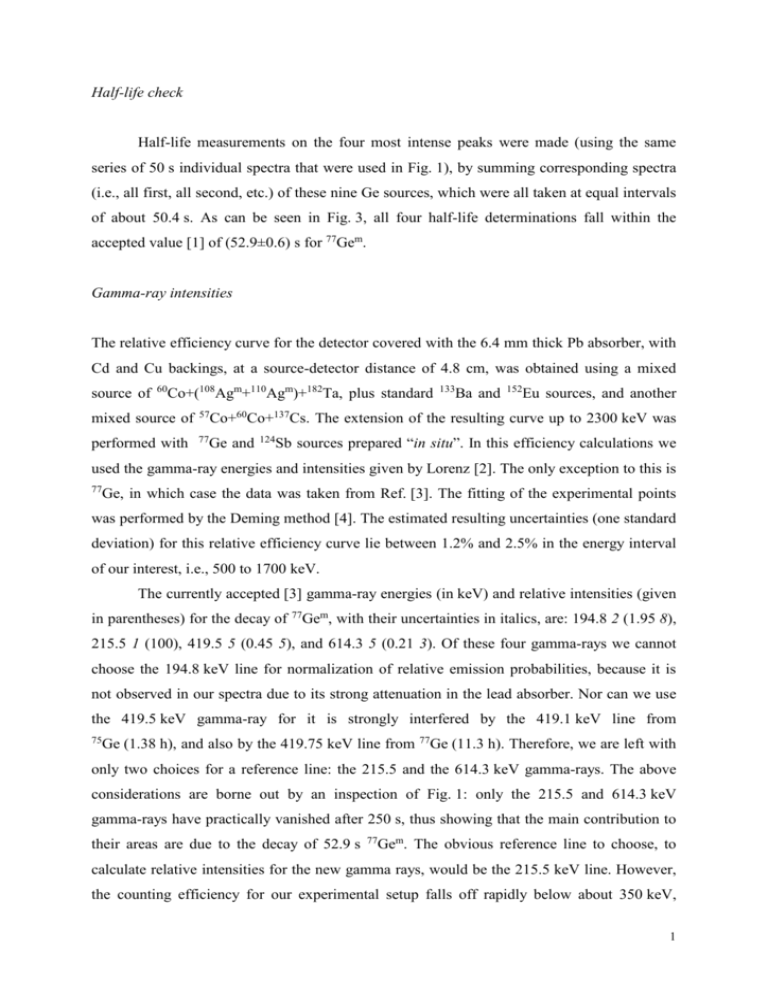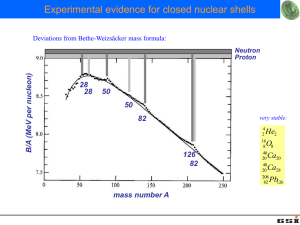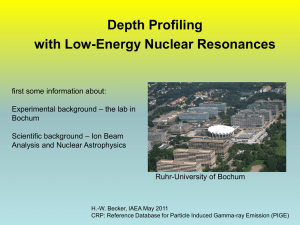Document - AIP FTP Server
advertisement

Half-life check Half-life measurements on the four most intense peaks were made (using the same series of 50 s individual spectra that were used in Fig. 1), by summing corresponding spectra (i.e., all first, all second, etc.) of these nine Ge sources, which were all taken at equal intervals of about 50.4 s. As can be seen in Fig. 3, all four half-life determinations fall within the accepted value [1] of (52.9±0.6) s for 77Gem. Gamma-ray intensities The relative efficiency curve for the detector covered with the 6.4 mm thick Pb absorber, with Cd and Cu backings, at a source-detector distance of 4.8 cm, was obtained using a mixed source of 60 Co+(108Agm+110Agm)+182Ta, plus standard mixed source of 57 performed with 77 133 Ba and 152 Eu sources, and another Co+60Co+137Cs. The extension of the resulting curve up to 2300 keV was Ge and 124 Sb sources prepared “in situ”. In this efficiency calculations we used the gamma-ray energies and intensities given by Lorenz [2]. The only exception to this is 77 Ge, in which case the data was taken from Ref. [3]. The fitting of the experimental points was performed by the Deming method [4]. The estimated resulting uncertainties (one standard deviation) for this relative efficiency curve lie between 1.2% and 2.5% in the energy interval of our interest, i.e., 500 to 1700 keV. The currently accepted [3] gamma-ray energies (in keV) and relative intensities (given in parentheses) for the decay of 77Gem, with their uncertainties in italics, are: 194.8 2 (1.95 8), 215.5 1 (100), 419.5 5 (0.45 5), and 614.3 5 (0.21 3). Of these four gamma-rays we cannot choose the 194.8 keV line for normalization of relative emission probabilities, because it is not observed in our spectra due to its strong attenuation in the lead absorber. Nor can we use the 419.5 keV gamma-ray for it is strongly interfered by the 419.1 keV line from 75 Ge (1.38 h), and also by the 419.75 keV line from 77Ge (11.3 h). Therefore, we are left with only two choices for a reference line: the 215.5 and the 614.3 keV gamma-rays. The above considerations are borne out by an inspection of Fig. 1: only the 215.5 and 614.3 keV gamma-rays have practically vanished after 250 s, thus showing that the main contribution to their areas are due to the decay of 52.9 s 77 Gem. The obvious reference line to choose, to calculate relative intensities for the new gamma rays, would be the 215.5 keV line. However, the counting efficiency for our experimental setup falls off rapidly below about 350 keV, 1 therefore the uncertainties below that energy increase rapidly. In effect, when calculating relative intensities for the new gamma-rays, the uncertainties associated with the reference line alone, amount to more than 50% when we chose the 215.5 keV gamma-ray as the reference line, as compared to about 3.9% for the 614.3 keV line. And these numbers change respectively to 51% and 19% when calculating absolute gamma-ray emission probabilities. Therefore, our choice as a reference line is the 614.3 keV gamma-ray. This gamma-ray is part of a doublet with the 617.7 keV gamma-ray from 75Ge (1.38 h). This doublet was resolved by hand (graphical peel-apart technique) and the 614.3 keV area obtained by cutting and weighing. The contribution of the 614.39 keV gamma-ray from the decay of 77Ge (11.3 h) was taken into account. All areas were corrected for self-attenuation produced in the germanium samples. These corrections varied from 1.8% to 3.2% for the gamma-ray energies involved. Gamma-rays and energy levels A short discussion regarding some of the new gamma-ray transitions and levels found in this work which are worth commenting on, follows. 264.44 keV: As mentioned in the main article, we detect a gamma-ray with an energy of 1339.99 keV, whose origin we assign to a partial depopulation of the proposed level at 1604.65 keV leaving the 77 As nucleus in its well established excited level [3] at (264.401±0.014) keV: (1604.65±0.10)–(1339.99±0.49)=(264.66±0.50) keV. Therefore, we submit that in the decay of 77 Gem a gamma-ray of 264 keV is also emitted, although we are unable to detect it with the present experimental setup. This is because this very weak 264 keV peak is strongly interfered by the 264.66 keV gamma-ray (I=11.3%) from the decay of 75Ge (1.38 h) and also, to a lesser amount, by the 264.44 keV gamma-ray (I=53.9%) from the decay of 77 Ge (11.3 h). In fact, a simple calculation shows that the contribution to the 264 keV peak-area from the 77Gem (53 s) decay (assuming that the proposed level at 264 keV is fed by the 1340 keV gamma-ray, probably also by a 1412 keV gamma-ray, and no feeding), amounts to less than one half the uncertainty corresponding to the experimentally measured peak-area at 264 keV (spectrum of Fig. 1a) which, as mentioned above, is mainly due to the contributions of the 75 Ge (1.38 h) and 77 Ge (11.3 h) decays. For lack of a better estimate, we establish lower and upper limits for the peak area corresponding to the proposed 264 keV gamma-ray. 2 503.86 keV: This peak is clearly observed in Figs.1 and 1a. Also, its decay with time is seen in Fig. 3. After having arrived at our proposed decay scheme of Fig. 2, it came to our attention that the existence of a level around this energy in 77 As, had already been seen by Betts et al. [5] at (514±7) keV, by Schrader et al. [6] at (503.0±0.9) keV, and by Rotbard et al. [7] at (503±3) keV. Betts et al. [5], and Schrader et al. [6], were looking at (3He,d) reactions on 76 Ge and from the deuteron energy spectra determined different excited levels in the residual nucleus 3 77 As. Similarly, Rotbard et al. [7] looked at (d,3He) reactions on 78 Se and from the He energy spectra also determined different excited states in the residual nucleus 77As. These values are in good agreement with our proposed level at 503.89 keV. 1412.50 keV: Although small, there is some evidence for the existence of this peak. This is because it is almost completely buried in the high energy tail of the “strong” peak at 1410 keV which, according to our results, is about 16 times stronger. Nevertheless, in one of our partial sum spectra we have a statistically significant indication of the existence of this peak. From this spectrum we get the energy and intensity given in Table 1 for the 1412 keV peak. Also, taking into account the considerations above for the 264 keV gamma-ray, it can be readily established that the sum: -intensity to the 264 keV level plus the 1412 keV gamma-ray intensity, is greater than (0.00000.0050)% and smaller than (0.00690.0091)%. It can be seen that this last value agrees with the intensity given in Table 1 for the 1412 keV peak. This would seem to indicate that the -branching to the 264 keV level is (0.00000.0094)%. Therefore, we believe it is safe to assume that this branching lies below 0.01%, and is probably zero if one takes into account -decay forbiddenness considerations. 1604.65 and 1676.46 keV: These are the strongest new gamma-rays we observe in our spectra and, from energy-sum relations, their placing as energy levels in the 77 As level scheme is a straightforward matter. Betts et al. [5] report an 77As level at (1674±7) keV. Schrader et al. [6] report levels at (1618±5) and (1652±5) keV. Rotbard et al. [7] report levels in 77 As at (1606±10) and (1660±10) keV. The levels reported in these experiments performing nuclear reactions probably correspond to these two levels proposed in the present work. It is interesting to note that M. Poncet [8], performing high-resolution -ray spectrometry, reports the existence of both these gamma-rays in the decay of 77 Ge (11.3 h), giving the following energy (relative intensity) values: 1605.0 keV (0.01) and 1676.6 keV (0.016), taking I(264 keV)=100. However, in Ref. [9], p. 264, these gamma-rays are mentioned with 3 question marks, and in Ref. [3], p. 257†, it is specifically said they were not taken into account for the listing of 77 77 As gamma-rays. In an attempt to see these gamma-rays in the decay of Ge (11.3 h), we irradiated a 187 mg Ge sample for 3 hours in a thermal neutron flux of about 11012 cm-2 s-1. Under these conditions, we were unable to see either of these two lines in a spectrum taken during 14.7 h after a 25 h-decay. From this spectrum, however, we can say that the relative intensity of both these lines lies below 0.020—referred to the 264 keV line taken as having a relative intensity of 100—for the ground-state decay of 77 Ge. These upper values are compatible with the work of M. Poncet [8]. † Although Ref. [3] refers to the work of C. Ythier and M. Poncet (C.R.Acad.Sci., Ser.B, 273, (1971) 407) as originating these data, there is no mention whatsoever of these gamma-rays in Ythier and Poncet’s paper. 4 References [1] J. K. Tuli, Nuclear Wallet Cards, National Nuclear Data Center, Brookhaven National Laboratory, Upton, New York, 1995. [2] A. Lorenz, in Handbook on Nuclear Activation Data, STI/DOC/10/273 (IAEA, Vienna, 1987), p. 187. [3] A. R. Farhan, S. Rab, and B. Singh, Nucl. Data Sheets 57 (1989) 223. [4] P. M. Rinard and A. Goldman, A curve-fitting package for personal computers, Los Alamos National Laboratory report LA-11082-MS, Rev.1(March 1988). [5] R. R. Betts, S. Mordechai, D. J. Pullen, B. Rosner, and W. Scholz, Nucl. Phys. A230 (1974) 235. [6] M. Schrader, H. Reiss, G. Rosner, and H. V. Klapdor, Nucl. Phys. A263 (1976) 193. [7] G. Rotbard, M. Vergnes, J. Vernotte, G. Berrier-Ronsin, J. Kalifa, and R. Tamisier, Nucl. Phys. A401 (1983) 41. [8] M. Poncet, Thesis, Univ. of Nice, (1971) 114 p. [9] C. M. Lederer and V. S. Shirley, Eds., Table of Isotopes, 7th edition (John Wiley & Sons, Inc., New York, 1978). 5




